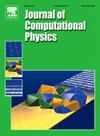Learning the solution operator of two-dimensional incompressible Navier-Stokes equations using physics-aware convolutional neural networks
IF 3.8
2区 物理与天体物理
Q2 COMPUTER SCIENCE, INTERDISCIPLINARY APPLICATIONS
引用次数: 0
Abstract
In recent years, the concept of introducing physics to machine learning has become widely popular. Most physics-inclusive ML-techniques however are still limited to a single geometry or a set of parametrizable geometries. Thus, there remains the need to train a new model for a new geometry, even if it is only slightly modified. With this work we introduce a technique with which it is possible to learn approximate solutions to the steady-state Navier–Stokes equations in varying geometries without the need of parametrization. This technique is based on a combination of a U-Net-like CNN and well established discretization methods from the field of the finite difference method. The results of our physics-aware CNN are compared to a state-of-the-art data-based approach. Additionally, it is also shown how our approach performs when combined with the data-based approach.
使用物理感知卷积神经网络学习二维不可压缩Navier-Stokes方程的解算子
近年来,将物理引入机器学习的概念已经变得非常流行。然而,大多数包括物理在内的机器学习技术仍然局限于单一几何或一组可参数化的几何。因此,仍然需要为新的几何形状训练一个新的模型,即使它只是稍微修改一下。在这项工作中,我们引入了一种技术,可以在不需要参数化的情况下学习不同几何形状的稳态Navier-Stokes方程的近似解。该技术基于类似u - net的CNN和有限差分法领域中成熟的离散化方法的结合。我们的物理感知CNN的结果与最先进的基于数据的方法进行了比较。此外,还展示了我们的方法与基于数据的方法结合使用时的性能。
本文章由计算机程序翻译,如有差异,请以英文原文为准。
求助全文
约1分钟内获得全文
求助全文
来源期刊

Journal of Computational Physics
物理-计算机:跨学科应用
CiteScore
7.60
自引率
14.60%
发文量
763
审稿时长
5.8 months
期刊介绍:
Journal of Computational Physics thoroughly treats the computational aspects of physical problems, presenting techniques for the numerical solution of mathematical equations arising in all areas of physics. The journal seeks to emphasize methods that cross disciplinary boundaries.
The Journal of Computational Physics also publishes short notes of 4 pages or less (including figures, tables, and references but excluding title pages). Letters to the Editor commenting on articles already published in this Journal will also be considered. Neither notes nor letters should have an abstract.
 求助内容:
求助内容: 应助结果提醒方式:
应助结果提醒方式:


